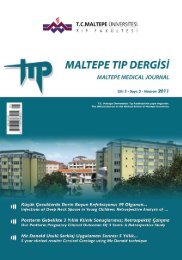Olgu sunumu - Maltepe Üniversitesi
Olgu sunumu - Maltepe Üniversitesi
Olgu sunumu - Maltepe Üniversitesi
You also want an ePaper? Increase the reach of your titles
YUMPU automatically turns print PDFs into web optimized ePapers that Google loves.
8<br />
Sinano¤lu et al<br />
<strong>Maltepe</strong> T›p Dergisi/ <strong>Maltepe</strong> Medical Journal<br />
INTRODUCTION<br />
Before Chaussy used extracorporeal shock wave<br />
lithotripsy (ESWL) in 1980, invasive methods have been<br />
used in the treatment of urinary stones (1). Since then,<br />
(ESWL) has been the treatment of choice for renal stones<br />
of ≤ 2 cm maximal length located in the calices or the renal<br />
pelvis (2). Considering its high efficacy, low rate of<br />
morbidity and complication, 3rd generation lithotriptors<br />
used in outpatient clinics became the major treatment<br />
option in urolithiasis. The higher trend to treat patients<br />
with ESWL can also be explained with no requirement of<br />
anesthesia. Although the definite time and criteria to<br />
evaluate stone-free status of a patient after ESWL<br />
treatment remained controversial for many years, it is now<br />
certain that clearance of disintegrates by three months is<br />
necessary to say that ESWL is succesful (3). The<br />
disintegration depends on stone volume (4), stone<br />
composition and localization, and type of lithotripter,<br />
applied shock wave number and energy (5). Clearance of<br />
disintegrates depends on their localization and is worse for<br />
those in the lower calyces than for those in the middle or<br />
upper calyces.<br />
In this study we report the early outcomes of 51<br />
patients treated with electrohydrolic Lithoshock ESWL<br />
device with fluoroscopic stone focusing.<br />
MATERIALS AND METHODS<br />
The data of 51 patients with diagnosis of urolithiasis<br />
undergoing endoscopic shock wave lithotripsy between<br />
July 2009 and July 2011 were reviewed. The diagnosis of<br />
urolithiasis was done either with Kidney Ureter Bladder film<br />
(KUB) plus ultrasound (US) or with computed tomography<br />
(CT). The calculi were focussed with C-Arm Fluoroscopy.<br />
Patients having pain, hydronephrosis due to stone<br />
obstruction, and stone size 5 ≥ mm were treated with<br />
ESWL. The patients with ureteropelvic junction<br />
obstruction, renal failure and urinary obstruction were<br />
excluded. Asymptomatic patients with stone size < 5 mm<br />
and no obstruction were followed up for spontaneous<br />
passage. If they are not stone-free during this period,<br />
ESWL or percutaneous nephrolithotomy for kidney stones<br />
and ureterorenoscopic lithotripsy for ureteral stones were<br />
carried out. Complete blood count, blood urea analysis,<br />
coagulation parameters were done before the procedure.<br />
Double-J catheters were inserted to 9 patients (%17)<br />
before ESWL sessions.<br />
Parenteral diclofenac or fentanyl was used in order to<br />
ensure analgesia. Electrohydrolic (Ultralith) ESWL device<br />
with fluoroscopic C-arm focussing was used. One to 5<br />
ESWL sessions (mean 3) were performed. 500 to 3500<br />
shock waves (Mean 2567) were applied for each session.<br />
Shock wave intensity varied from 10 to 22 kv (mean 18 kv).<br />
On 10th, 30th and 90th days following the last ESWL<br />
session, patients were checked with KUB films and/or<br />
ultrasound, stone free status were defined with evidence<br />
of disintegration and spontaneous passage of<br />
disintegrates.<br />
RESULTS<br />
Of these 51 patients, 38 were male (74.5 %) 13 were<br />
female (25.5 %). Ages varied from 20 to 73 (mean 41.7<br />
years). Three had (5.9%) upper calyceal, 9 had (%17.6) mid<br />
calyceal, 12 had lower calyceal (23.5%), 9 had renal pelvis<br />
(17.6%) and, 18 had ureteral(35.3%) stones. Stone sizes<br />
varied from 5-30 mm (mean 10.5). After 3 months follow<br />
up 44 patients became stone free (86%.) Out of 33 renal<br />
and 18 ureteral stones 29 (88%) and 13 (72%) were<br />
succesfuly cleared. Table 1 shows the success rate of ESWL<br />
with respect to stone localization. Two patients required<br />
ureterorenoscopic lithotripsy due to the complication of<br />
distal ureteral obstruction by abundant stone fragments<br />
which is also called as “Steinstrasse” phenomenon. Table 2<br />
gives the status of complete stone disintegration and<br />
clearance as well as treatment failure in details. Five patients<br />
underwent invasive intervention modalities including<br />
ureterorenoscopic lithotripsy and percutaneous<br />
nephrolithotomy due to ESWL failure. Complications such as<br />
renal hematoma, hypertension, renal failure or infection<br />
were not seen in any patients after ESWL treatment.<br />
Petechiae, ecchymosis, and macroscopic hematuria shorter<br />
than 24 hours were seen in all cases. The success rates for<br />
Stone localization Stone Free Success Rate<br />
Upper Calyx 2/3 67%<br />
Mid Calyx 9/9 100%<br />
Lower Calyx 11/12 92%<br />
Renal Pelvis 7/9 78%<br />
Proximal Ureter 12/13 92%<br />
Mid Ureter 1/3 33%<br />
Distal Ureter 0/2 0%<br />
Table 1. Success rates according to stone localization<br />
Stone status # Patients Percentage<br />
*Stone free 44 87 %<br />
**Non Stone free 5 16 %<br />
***Steinstrasse 2 3 %<br />
Total 51 100 %<br />
Table 2. Overall success and failure rates after ESWL<br />
treatment *Complete disintegration and passage of<br />
disintegrates, **Incomplete disintegration or failure to pass<br />
disintegrates ***Persistent ureteral obstruction due to<br />
impacted disintegrates requiring immediate endoscopic<br />
intervention



